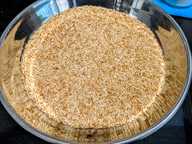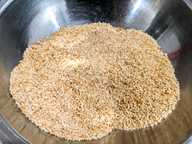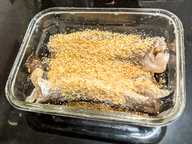




Paddy fields abound in the northern states of peninsular Malaysia. And when there are paddy fields and waterways, there are freshwater fish. Many kampung folks catch freshwater fish as a cheap source of protein, and pekasam is a way of fermenting a glut of a catch. This recipe is perfect for those with a keen interest in fermentation and want to make the leap to fermenting animal products.
Read our story behind the science of pekasam here.
Tableware by Ilham Ceramic Studio.
Pekasam ikan
by Encik RamliPaddy fields abound in the northern states of peninsular Malaysia. And when there are paddy fields and waterways, there are freshwater fish. Many kampung folks catch freshwater fish as a cheap source of protein, and pekasam is a way of fermenting a glut of a catch. This recipe is perfect for those with a keen interest in fermentation and want to make the leap to fermenting animal products.
Read our story behind the science of pekasam here.
Tableware by Ilham Ceramic Studio.
Servings: 4
Prep time: A project





Servings: 4
Prep time: A project
Ingredients
FOR FERMENTING:
4-5 freshwater fish (ikan sepat, keli, puyu, haruan), about 150g each or 800g in total
30g salt
2-3 heaped tbsp gula Melaka
1 cup toasted fragrant rice powder
2-3 pieces asam keping (optional)
FOR COOKING:
1 large onion, sliced
2 large dried red chillies, cut into pieces
Directions
- Gut, scale (if scaly), and clean the fish as thoroughly as possible. Lather 30g of salt all over the fish, into every crevice. Set it in an air-tight container and leave in a cool place for 36 hours.
- In the meantime, toast uncooked fragrant rice in a dry pan over low heat until golden brown. This will take about an hour at least.
- Blend or grind the toasted rice, salt to taste, and gula Melaka until it becomes a fine powder.
- After 36 hours, remove fish from the container and wash it with water. Rinse out the container as well, as much of the liquids will have drained out of the fish during its salt soak.
- Place the washed fish back into the container then pour the toasted rice powder mix along with asam keping over the fish. Rub this mix all over the fish, into every crevice. Close the container tight, make sure it has no leaks. Leave it in a cool place for 10-14 days.
- After 10-14 days, open the container. It should smell earthy, musty, fishy, but not in an unpleasant way. See tips below for more notes on how to assess your pekasam.
- If you have successfully fermented the fish, this can now be fried for a meal. Heat a frying pan over medium heat, and add enough oil to pan fry. Do not remove the rice from the fish.
- Fry the sliced onions and cut dried chillies in the pan until the onions have taken on a little colour but is not burnt. Remove from the oil and set on a plate.
- Add the fermented fish to the oil along with the rice powder, and fry until the rice toasts to a golden brown. If some of the rice powder is darkening too quickly, remove some powder from the pan and place together with the onions and chillies. As the fish has already fermented (read: cooked) it will only take about 5 minutes maximum to fry the fish, depending on the size of the cuts. Transfer the fish and powder to the plate and serve with rice.
Tips
- Freshwater fish is highly recommended and more easily available than one might think. Visit your local wet market and ask someone to point out the vendor for ‘ikan sungai’ and the fishmonger should be able to point out what’s best for pekasam. You can also fish for your own—go to a paddy field or as far upstream as possible and use floaters (not sinkers) with live bait such as earthworms, crickets, or small frogs.
- Saltwater fish can also be used but will have a different outcome on overall flavour.
- During the first salt fermentation, watery liquids will seep out of the fish via osmosis. Remove this liquid.
- Trust your nose and eyes, and recognise the difference between a good fishy smell and a bad fishy smell. After the second fermentation, if it smells bad, or if you spot fungus or maggots, it has spoiled and should be thrown out. We recommend that you buy a pre-made pekasam first to have a sense of what it should smell and look like.
- Clear glass airtight containers are best for this process so that you can see what’s happening inside without opening the container.
Ingredients
FOR FERMENTING:
4-5 freshwater fish (ikan sepat, keli, puyu, haruan), about 150g each or 800g in total
30g salt
2-3 heaped tbsp gula Melaka
1 cup toasted fragrant rice powder
2-3 pieces asam keping (optional)
FOR COOKING:
1 large onion, sliced
2 large dried red chillies, cut into pieces
Directions
- Gut, scale (if scaly), and clean the fish as thoroughly as possible. Lather 30g of salt all over the fish, into every crevice. Set it in an air-tight container and leave in a cool place for 36 hours.
- In the meantime, toast uncooked fragrant rice in a dry pan over low heat until golden brown. This will take about an hour at least.
- Blend or grind the toasted rice, salt to taste, and gula Melaka until it becomes a fine powder.
- After 36 hours, remove fish from the container and wash it with water. Rinse out the container as well, as much of the liquids will have drained out of the fish during its salt soak.
- Place the washed fish back into the container then pour the toasted rice powder mix along with asam keping over the fish. Rub this mix all over the fish, into every crevice. Close the container tight, make sure it has no leaks. Leave it in a cool place for 10-14 days.
- After 10-14 days, open the container. It should smell earthy, musty, fishy, but not in an unpleasant way. See tips below for more notes on how to assess your pekasam.
- If you have successfully fermented the fish, this can now be fried for a meal. Heat a frying pan over medium heat, and add enough oil to pan fry. Do not remove the rice from the fish.
- Fry the sliced onions and cut dried chillies in the pan until the onions have taken on a little colour but is not burnt. Remove from the oil and set on a plate.
- Add the fermented fish to the oil along with the rice powder, and fry until the rice toasts to a golden brown. If some of the rice powder is darkening too quickly, remove some powder from the pan and place together with the onions and chillies. As the fish has already fermented (read: cooked) it will only take about 5 minutes maximum to fry the fish, depending on the size of the cuts. Transfer the fish and powder to the plate and serve with rice.
Tips
- Freshwater fish is highly recommended and more easily available than one might think. Visit your local wet market and ask someone to point out the vendor for ‘ikan sungai’ and the fishmonger should be able to point out what’s best for pekasam. You can also fish for your own—go to a paddy field or as far upstream as possible and use floaters (not sinkers) with live bait such as earthworms, crickets, or small frogs.
- Saltwater fish can also be used but will have a different outcome on overall flavour.
- During the first salt fermentation, watery liquids will seep out of the fish via osmosis. Remove this liquid.
- Trust your nose and eyes, and recognise the difference between a good fishy smell and a bad fishy smell. After the second fermentation, if it smells bad, or if you spot fungus or maggots, it has spoiled and should be thrown out. We recommend that you buy a pre-made pekasam first to have a sense of what it should smell and look like.
- Clear glass airtight containers are best for this process so that you can see what’s happening inside without opening the container.





